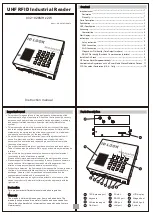
instabus EIB
Technical Product Information
September 2001
Binary Input N 260
5WG1 260-1AB01
4 x 230 V AC
Product and Applications Description
Siemens AG
N 260, 4 pages
Technical Manual
The binary input N 260 is a N-system DIN-rail mounted
device with four inputs for AC 230 V switching or keying
signals from separate external outside lines (L1, L2, L3)
with a shared reference potential (N).
Each of the inputs can be assigned various tasks
depending on the application program used, i.e. the
binary input N 260 consists of the device (hardware) and
its application programs (software).
Appropriate application programs are available for
the different tasks the binary input N 260 can handle;
e.g. sending of on/off telegrams at different edges of the
input signal either event-controlled or cyclic with
parametrisable repetition intervals.
With the ETS (
EIB
Tool Software) the application
program is selected, its parameters and addresses are
assigned appropriately, and downloaded to the binary
input N 260.
Applikationsprogramme
12 S4 BinCycl 240505
•
4 binary inputs
•
each input allows switching on/off or toggling at
leading or trailing edge
•
allows cyclic sending
•
allows sending at bus voltage recurrence
•
sending condition can be set
12 S2 On-off-toggle/Dim/Shu 220703
•
4 binary inputs
•
allows configuration for dimmer/shutter or
on/off/sending value
•
switching at leading edge or at leading and trailing
edge
•
switching short/long key depression
•
sending value at leading edge or at leading and
trailing edge
•
duration of long key depression can be set
•
used type of contacts can be set
11 S4 BinVal 240A01
•
4 binary inputs
•
each input allows to send values at leading edge
and/or at leading and trailing edge
•
allows cyclic sending
•
allows delay
•
allows interlocking
Example of Operation
in
st
ab
us
E
IB
binary input N 260
switching /
keying signals
load circuit
AC 230/400V
L1
bu
s c
oup
lin
g
un
it
L2 L3 N
channel A
channel B
channel C
N
channel D
2
4
3
6
1
5
Installation Instructions
•
The device may be used for permanent interior
installations in dry locations within distribution boards.
V
WARNING
•
The device may be built into distribution boards
(230/400 V) if VDE-certified devices are used
exclusively and must be mounted and commissioned
by an authorised electrician.
•
A safety disconnection of the device must be possible.
Especially if the device is connected to different
phases.
•
Free DIN rail areas must be covered with covers,
order no. 5WG1 192-8AA01.
•
The prevailing safety rules must be heeded.
•
The device must not be opened. A device suspected
faulty should be returned to the local Siemens office.
Automation and Drives Group
Electrical Installation Technology
Siemens AG 2001
Update: http://www.siemens.de/installationstechnik
P.O.Box 10 09 53, D-93009 Regensburg
Subject to change without prior notice
2.7.1.3/1





















